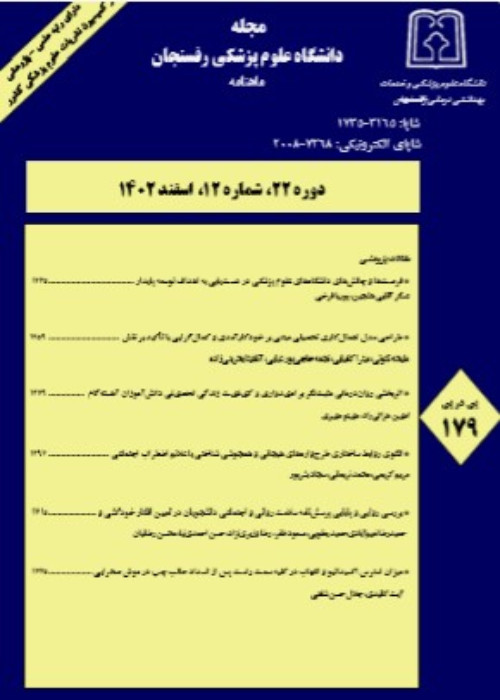Effectiveness of a Theory-Based Educational Intervention on Modifying Body Posture of Computer Users in Iran
Author(s):
Abstract:
Background And Objectives
Computer users are susceptible to musculoskeletal disorders. The association between musculoskeletal disorders especially low back pain and sitting posture in the occupational setting has been confirmed in available studies. The main aim of this study was to determine the effectiveness of an educational intervention on body posture modification and psychosocial mediating variables based on the Theory of Planned Behavior (TPB). Materials And Methods
In this quasi-experimental study، 75 computer users from Qazvin university of medical sciences who spent at least 20 hours per week at a VDT were selected to receive the ergonomic intervention، and the same number of students from Qazvin international university were assigned to a control group randomly. Both groups were evaluated at the beginning of the study and at a follow-up 3 and 6 months later. The following tools were used; the Rapid upper limp Assessment (RULA) method to assess upper-extremity work-related posture، self administrated questionnaire that evaluated TPB constructs and ergo – knowledge quiz. The tool’s internal consistency reliability، Cronbach alpha reliability coefficient، test–retest reliability، content and face validity were examined. The intervention included two program elements; theory-based brochure، and personalized preventive educational counseling. Data analyzed by χ2، independent t test، repeated measure ANOVA and Kruskal Wallis test. Results
Total tools ’ psychometric value was acceptable. The intervention group had significantly higher scores than controls in ergo-knowledge، attitudes، perceived behavior control، intention، as well as nonneutral posture maintenance as goal behavior (P< 0. 05). At 3 and 6 months follow up، no significant differences were found between the two groups for subjective norms constructs. Intervention failed to improve RULA risk level to low and very low area (1، 2 level) and it only decreased the risk exposure to medium level. Conclusions
Our findings showed that the theory-based ergonomic interventions may improve work-related posture but this effect per se failed to decrease ergonomic risk factors to low level of risk exposure. The results suggest that preventive ergonomic activities would be more successful if educational intervention regarded as a part of multifaceted interventions that include at least two of the following aspects; analysis and elimination of risk factors، engineering and administrative controls.Keywords:
Language:
Persian
Published:
Journal of Rafsanjan University Of Medical Sciences, Volume:11 Issue: 2, 2012
Pages:
145 to 158
magiran.com/p1006498
دانلود و مطالعه متن این مقاله با یکی از روشهای زیر امکان پذیر است:
اشتراک شخصی
با عضویت و پرداخت آنلاین حق اشتراک یکساله به مبلغ 1,390,000ريال میتوانید 70 عنوان مطلب دانلود کنید!
اشتراک سازمانی
به کتابخانه دانشگاه یا محل کار خود پیشنهاد کنید تا اشتراک سازمانی این پایگاه را برای دسترسی نامحدود همه کاربران به متن مطالب تهیه نمایند!
توجه!
- حق عضویت دریافتی صرف حمایت از نشریات عضو و نگهداری، تکمیل و توسعه مگیران میشود.
- پرداخت حق اشتراک و دانلود مقالات اجازه بازنشر آن در سایر رسانههای چاپی و دیجیتال را به کاربر نمیدهد.
In order to view content subscription is required
Personal subscription
Subscribe magiran.com for 70 € euros via PayPal and download 70 articles during a year.
Organization subscription
Please contact us to subscribe your university or library for unlimited access!


